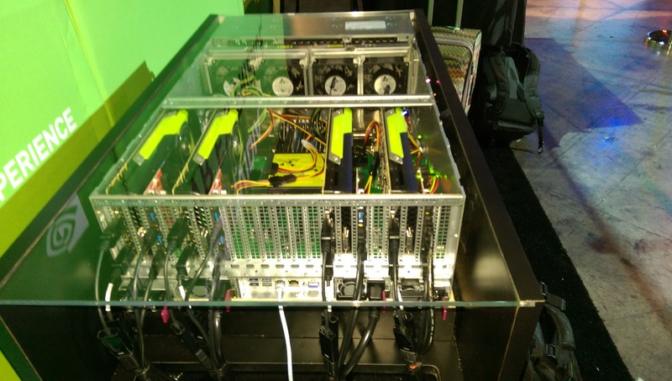Nvidia Shows Off Quadro P6000-Powered Multi-User VR System At GTC
Nvidia is showing off a multi-user VR environment at the GPU Technology Conference (GTC) in San Jose. The company said that its goal was to show that multiple people can participate in a shared VR experience on a single system--even if it had to stretch the definition of "single system" to do so.
In this case, the "single system" is a server packed with four Quadro P6000 GPUs running four virtual machines dedicated to four HTC Vive Business Edition headsets. This setup, in conjunction with HTC's Lighthouse tracking system, allows four people to use VR within the same physical space. It's an interesting proof of concept that GTC attendees can experience for themselves, but it's also unlikely to come to your living room any time soon.
A single Quadro P6000 costs $5,500. One HTC Vive Business Edition headset runs $1,200. That means you're going to spend at least $26,800 on this system--and that's before you think about the case, cooling, power supply, and every other component Nvidia didn't highlight in its blog post. It's hard to imagine any but the largest of businesses spending that kind of money just to let four people have a shared VR experience in one room.
Nvidia said this system is meant for "everything from amusement parks and arcades to military and first responder training, to manufacturing and design," as well as the "customized VR spaces popping up at cinemas, shopping malls, and elsewhere." Those industries might be willing to spend upwards of $30,000 on a multi-user VR environment. It seems that VR enthusiasts, on the other hand, are still going to have to wait a little longer.
“The possibilities are endless,” said Tom Kaye, a senior solutions architect at Nvidia who helped develop the system. “With the addition of remote management and reliability features, such as multiple templates, clone on boot and remote rebuilds, we could see system builders working to create a robust, ready-to-deploy multi-user VR appliance.”
If you're at GTC, you can check out this system at the conference's VR Village. Kaye and Fred Devoir will also give a talk about the system today (May 8) at 10:30am PT, and you can request a copy of a technical document explaining how to build a system like this by filling out this form. And if you're just curious about the Quadro P6000 inside the machine, check out our report on the Pascal-based Quadro lineup that debuted in February.
Get Tom's Hardware's best news and in-depth reviews, straight to your inbox.

Nathaniel Mott is a freelance news and features writer for Tom's Hardware US, covering breaking news, security, and the silliest aspects of the tech industry.
-
bit_user The use of VMs is interesting. It's good that it can work with VMs, but it sorta feels like they had to use VMs to support multiple Vives on one system.Reply
Anyway, the use of P6000's is simply gratuitous. IRL, I'd imagine people would just use GTX 1070's or perhaps P4000's if 1070's don't handle continuous day-long usage well enough. -
pegnose Aside from the HUGE amount of 24 GB of Vram those cards are not so very different from 1080 Ti's (with 11 GB). And as they are using VMs, likely communicating via network, you could also just buy 4 "regular" gaming PCs (and a cheap Ethernet switch) sporting a 1080 Ti each for ~8k bucks plus headsets.Reply -
pegnose Also, this mega-box is quite useless without a good multi-user wireless solution for the headsets.Reply
